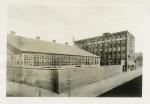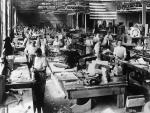![header=[Marker Text] body=[Pioneer in development of alternating current, permitting transmission of electricity over long distances. Founded 1886 by George Westinghouse, it made AC motors, generators, transformers in a plant at Garrison Place and Penn Avenue.] sign](http://explorepahistory.com/kora/files/1/10/1-A-33D-139-ExplorePAHistory-a0l2s4-a_450.jpg)
Mouse over for marker text
Name:
Westinghouse Electric Corporation [Industries]
Region:
Pittsburgh Region
County:
Allegheny
Marker Location:
Westinghouse Plaza, 6 Gateway Center, Pittsburgh
Behind the Marker
Electricity is so much a part of our everyday lives that we take its numerous uses for granted, until a power outage demonstrates how difficult it is to do almost anything without it.  George Westinghouse was one of the pioneers of our modern electrical power system that includes powerful generators, efficient transmission over long distances, and safe utilization.
George Westinghouse was one of the pioneers of our modern electrical power system that includes powerful generators, efficient transmission over long distances, and safe utilization.
Westinghouse was a prolific inventor and engineer comparable to Thomas Edison, with whom he competed to determine the superiority of alternating versus direct current. Westinghouse's alternating current system became widely adopted, while Edison's direct current system faded away. Westinghouse, born in Central Bridge, New York, in 1846, had his first introduction to technology as a young man working for his father, who manufactured agricultural machinery.
Although only a teenager, he served in the Civil War and at age eighteen obtained engineering experience in the Navy. Immediately after the war he launched his career as an inventor by obtaining a patent on a rotary steam engine. He soon followed with his first successful invention, a device that allowed derailed railroad cars to be easily pulled back onto the tracks.
To find a manufacturer for his invention, Westinghouse moved to Pittsburgh in 1867. It was about this time that he also conceived of his first major invention, automatic air brakes for trains. Stopping a long, fast moving train was a major problem for railroads and poor braking led to some disastrous accidents. The standard approach was for brakemen to scramble over the cars and manually apply a brake on each car. Westinghouse used pipes filled with compressed air to automatically apply the brakes on the wheels of each car. Now the engineer was in full control of his train.
Westinghouse's air brakes were a timely invention, and by the mid-1870s most passenger trains had installed them. (Congress would mandate their use on freight trains in 1893.) Following this triumph he worked next on automatic signaling devices that alerted engineers to the presence of another train on the tracks ahead. Once again using air pressure he developed a system in 1879.
By this time, however, another technology that could act at a distance was in the news. Thomas Edison was making headlines with his incandescent electric light bulb. Westinghouse watched in the early 1880s as Edison built numerous direct current systems for electric lighting. These systems were limited in size because direct current electricity could be transmitted efficiently for only about a mile from its source. In Europe researchers were investigating methods for transmitting electricity efficiently over long distances, specifically to capture the energy of large waterfalls that were distant from urban centers.
Scientists discovered that alternating current–electrical current that rapidly switches back and forth in direction–our modern system does this 60 times per second–could be raised to very high voltages that could be transmitted efficiently over long distances. In the early 1880s the major problem with alternating current was the lack of an efficient transformer to lower the voltage from thousands of volts to much lower voltages used in homes and factories.
In 1884, Westinghouse entered this field by forming the Westinghouse Electric Company and soon bought the rights to a transformer invented in Europe by Lucian Gaulard and John Dixon Gibbs. At this point Westinghouse apparently shifted his focus from invention to engineering and management. To improve the transformer, he hired William Stanley, one of the era's many independent inventors, and in 1886, Stanley provided the town of Great Barrington, Massachusetts, with the first alternating current lighting.
After solving the transformer problem, Westinghouse acquired the talents of the flamboyant immigrant inventor Nikola Tesla, who had developed a motor that would run on alternating current. After much engineering effort, Westinghouse had a complete system to compete with Edison's direct current installations.
The key advantage of alternating current–efficient transmission over longer distances–eventually defeated Edison and direct current. This was dramatically demonstrated in 1893 when Westinghouse was awarded a contract to build three giant alternating current generators to harness the energy of Niagara Falls to provide electricity for nearby Buffalo. Because there were few waterfalls with the power of Niagara, Westinghouse in the 1890s acquired a steam turbine invented by Englishmen Charles Parsons. In 1899, Westinghouse installed the first large steam turbine generator–a technology still used today–in Hartford, Connecticut.
By 1900, the various Westinghouse companies employed over 50,000 people; however, he lost control of his industrial empire during the financial panic of 1907. He died in 1914, but the company he founded became a large diversified electrical manufacturer and a pioneer in radio in the 1920s.
Westinghouse was a prolific inventor and engineer comparable to Thomas Edison, with whom he competed to determine the superiority of alternating versus direct current. Westinghouse's alternating current system became widely adopted, while Edison's direct current system faded away. Westinghouse, born in Central Bridge, New York, in 1846, had his first introduction to technology as a young man working for his father, who manufactured agricultural machinery.
Although only a teenager, he served in the Civil War and at age eighteen obtained engineering experience in the Navy. Immediately after the war he launched his career as an inventor by obtaining a patent on a rotary steam engine. He soon followed with his first successful invention, a device that allowed derailed railroad cars to be easily pulled back onto the tracks.
To find a manufacturer for his invention, Westinghouse moved to Pittsburgh in 1867. It was about this time that he also conceived of his first major invention, automatic air brakes for trains. Stopping a long, fast moving train was a major problem for railroads and poor braking led to some disastrous accidents. The standard approach was for brakemen to scramble over the cars and manually apply a brake on each car. Westinghouse used pipes filled with compressed air to automatically apply the brakes on the wheels of each car. Now the engineer was in full control of his train.
Westinghouse's air brakes were a timely invention, and by the mid-1870s most passenger trains had installed them. (Congress would mandate their use on freight trains in 1893.) Following this triumph he worked next on automatic signaling devices that alerted engineers to the presence of another train on the tracks ahead. Once again using air pressure he developed a system in 1879.
By this time, however, another technology that could act at a distance was in the news. Thomas Edison was making headlines with his incandescent electric light bulb. Westinghouse watched in the early 1880s as Edison built numerous direct current systems for electric lighting. These systems were limited in size because direct current electricity could be transmitted efficiently for only about a mile from its source. In Europe researchers were investigating methods for transmitting electricity efficiently over long distances, specifically to capture the energy of large waterfalls that were distant from urban centers.
Scientists discovered that alternating current–electrical current that rapidly switches back and forth in direction–our modern system does this 60 times per second–could be raised to very high voltages that could be transmitted efficiently over long distances. In the early 1880s the major problem with alternating current was the lack of an efficient transformer to lower the voltage from thousands of volts to much lower voltages used in homes and factories.
In 1884, Westinghouse entered this field by forming the Westinghouse Electric Company and soon bought the rights to a transformer invented in Europe by Lucian Gaulard and John Dixon Gibbs. At this point Westinghouse apparently shifted his focus from invention to engineering and management. To improve the transformer, he hired William Stanley, one of the era's many independent inventors, and in 1886, Stanley provided the town of Great Barrington, Massachusetts, with the first alternating current lighting.
After solving the transformer problem, Westinghouse acquired the talents of the flamboyant immigrant inventor Nikola Tesla, who had developed a motor that would run on alternating current. After much engineering effort, Westinghouse had a complete system to compete with Edison's direct current installations.
The key advantage of alternating current–efficient transmission over longer distances–eventually defeated Edison and direct current. This was dramatically demonstrated in 1893 when Westinghouse was awarded a contract to build three giant alternating current generators to harness the energy of Niagara Falls to provide electricity for nearby Buffalo. Because there were few waterfalls with the power of Niagara, Westinghouse in the 1890s acquired a steam turbine invented by Englishmen Charles Parsons. In 1899, Westinghouse installed the first large steam turbine generator–a technology still used today–in Hartford, Connecticut.
By 1900, the various Westinghouse companies employed over 50,000 people; however, he lost control of his industrial empire during the financial panic of 1907. He died in 1914, but the company he founded became a large diversified electrical manufacturer and a pioneer in radio in the 1920s.










